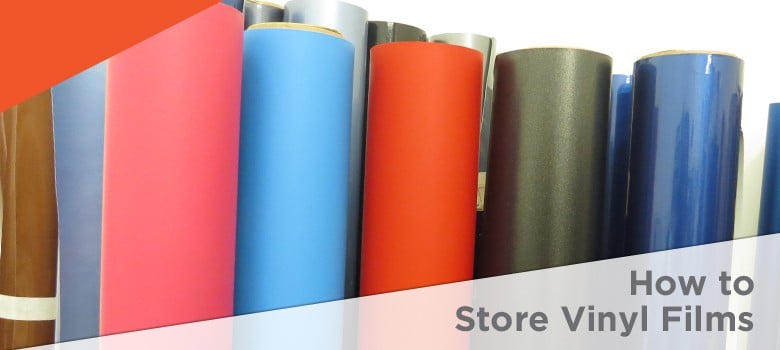When it comes to storing vinyl there are a few things to keep in mind that will prove to be the difference between being able to use that roll of film you have been saving for a job “just this size” or throwing it away in frustration.
Recommendations
The four storage tips to ensure your unused rolls remain at their best are:
- Establish Ideal Storage Temperature
- Avoid Excess Humidity & Water Contact
- Avoid Surface Pressure
- Inventory Management
The recommended way to store vinyl rolls is at controlled temperature and humidity, target 75°F and 50% Relative Humidity.
Storage temperature above 75°F accelerates adhesive degradation and can reduce the bond of your graphics by a great deal in a year or so. In fact, many materials stored in non-air conditioned warehouse spaces can have shelf life reduced by 50% of the time manufacturers publish. Usually the penalty is loss of adhesion but products meant for the printing markets can also develop printing defects that make them virtually unusable. Keep slow moving rolls in the coolest part of your shop or warehouse to assure that they are in good shape when you finally find that small job that is “just perfect” for your partial roll.
Excessive relative humidity or outright water contact will damage all paper and paper based release liners. In the best case, the unprotected product will “wick” moisture along the cut edge, develop waviness and become difficult to manage on the work bench or through a cutter or printer. In the worst case where liquid water has come in contact with these liners the release will tighten, bits of paper will stick to the adhesive or the liner will actually split when removing it from the vinyl. Keep rolls in their box or at the very least in their protective bag, and away from direct contact with concrete floors or exterior wall to assure that they remain as dry as possible.
Extreme pressure on any surface of a roll will result in surface marring (often called mottling) and can completely ruin a roll of film if many rolls have been stacked on top of one another or if a full roll has rested on its side for a long period of time. All vinyl is soft enough to take a pressure mark, some vinyl is very soft indeed; in addition glossy and very dark colors such as black will show pressure marks more dramatically than light colored, matte finish films such as white. One storage tip is to keep rolls stored vertically instead of horizontally. Aside from the fact that vertical storage is more ergonomic, especially if used in combination with mobile roll storage stands; vertical storage also applies far less pressure to the rolls.
One last thing to keep in mind is to have a good idea of what is on-hand to help reduce slow moving inventory – if you can’t see exactly what you have or how much of it is on the roll it is more likely to sit around job after job enduring the perpetual sorting and shuffling that is also very bad for rolls. Taking the time to label partial roll boxes or protective bags with a product and remaining length are a real help in identifying a roll I need for a particular job.
All this being said, practicing good job estimating in the first place and following up with “first in, first out” inventory management cuts out a great deal of the risk of dealing with aging inventory.




Good day I’m currently situated in a place where it often gets minus during the night, my vinyl is stored in a store,however I still feel like the cold is having an impact as I now need to ” press” at around 80, where I used to press around 50 and to weed it is still actually difficult , I bought a new blade and only other problem I can see is that it’s the cold, if I do a manual cut or even a test I can weed it, but it still doesn’t always cut through vinyl and can still be difficult to remove cut vinyl from the backing, do you perhaps have any tips, I’m thinking of building a crate to store the vinyl in.
Hi Francios, We suggest you look at the condition of the cutting strip of your machine. We’d love to help you narrow down your problem with the film. Contact us on our website and provide the vinyl product you are trying to cut, and the machine you are using, and we can try to resolve your cutting and weeding issues.
we need to store our vinyl rolls horizontally on pallets 3 across
looking for contoured supports
for under and over rolls for stacking